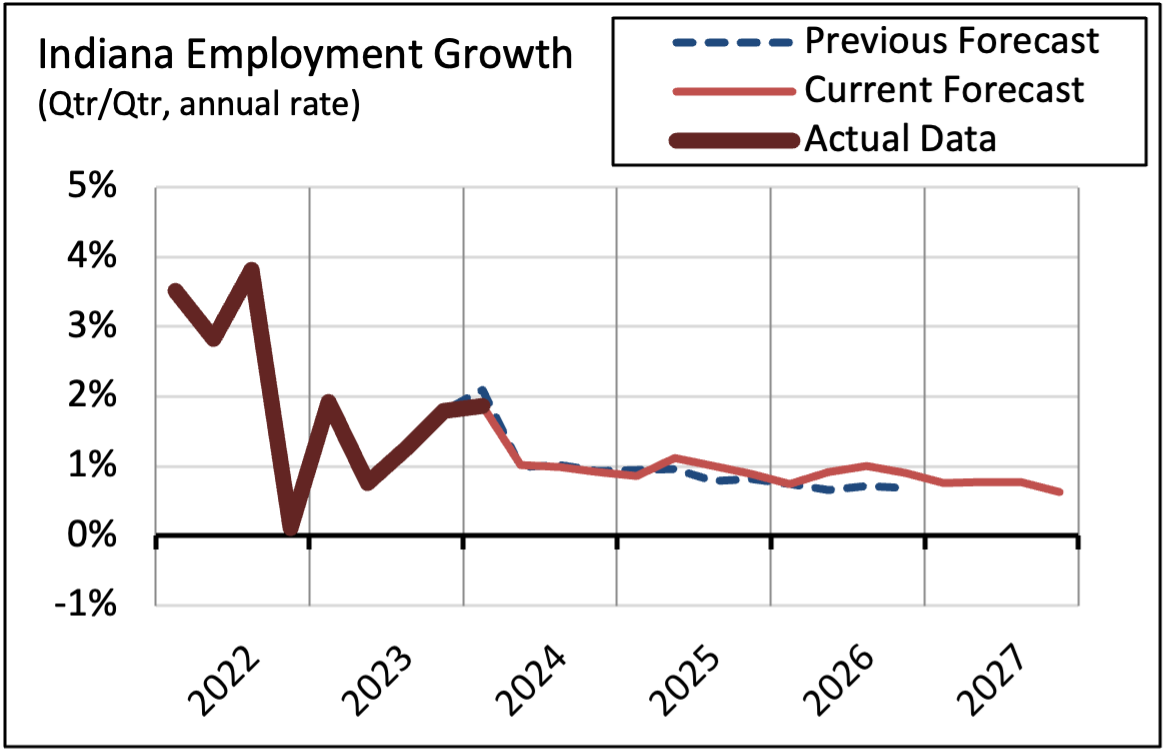July 2024
As in our forecast three months ago, our revised outlook is based on a scenario in which the Federal Reserve successfully achieves disinflation, with a smooth deceleration in growth to its long-run potential rate. The growth slowdown occurs mostly during the current year. For Indiana it produces a slowing in job creation, while income growth holds up relatively well. Beyond 2024 both employment and income show acceptable growth, although slightly below the national rate.
Data
This forecast uses data through 2023Q1 for both employment and income, and also for real output. For the latter, however, the BEA has released revised state level data beginning only with 2018Q1. Data prior to 2018 is not yet available on a comparable basis.
Following our standard procedure, with the availability of data into a new year, we have added a year to our forecast horizon. Consequently, our forecast period now covers the fifteen quarters from 2024Q2 through 2027Q4.
Baseline Forecast: Employment
From 2013 to 2019 Indiana employment increased at an annual rate of 1.17 percent. Over the past 17 quarters, going back to the start of the pandemic, the state has had job growth at an annual rate of 0.79 percent. As can be seen in the chart, our current forecast has job creation exceeding that level during the next year and a half (averaging 1.12 percent), but then falling a little short in 2027. The outlook for 2025-2026 is more optimistic than in our previous forecast.

Indiana employment growth has been below that in the nation for most of the past three years. In our forecast the state’s employment growth remains slightly below the national rate during the forecast period. For the fifteen quarters of our forecast, we expect Indiana job creation to average 0.89 percent per quarter. This exceeds the recent past, but it is below both the pre-pandemic period and our 1.03 percent expectation for the U.S.
Our new forecast for unemployment has a larger increase than in our April outlook. This reflects a similar change in our forecast for the U.S. economy. The unemployment rate in Indiana has consistently been below the U.S. rate since 2014. This continues in our forecast period with a gap that averages -0.4 percent, which is about equal to the pre-pandemic disparity.
Baseline Forecast: Personal Income
As shown in the below chart, our forecast this month has growth fluctuating over the next four years around average growth of 4.0 percent. Growth is above that average for most of this year and a little below during 2025.

Historically income growth in Indiana has fallen short of that at the national level. Over the 2013-2019 period this shortfall was 0.5 percent. This pattern reversed during both the shutdown and the restart periods. But it reappeared in 2023 and continues during our forecast. Over our full forecast period the Indiana income growth deficit relative to the nation averages 0.6 percent.
Conclusion
Our current outlook for Indiana is both pessimistic and optimistic. During the next year we expect a slowdown in employment growth, but only to a rate about in line with long-run potential, which matches that in the pre-pandemic period. Income growth slows slightly during the middle part of our forecast, but then stabilizes. In addition, for both employment and income, the growth we are forecasting falls short of our expectation for the national level.

